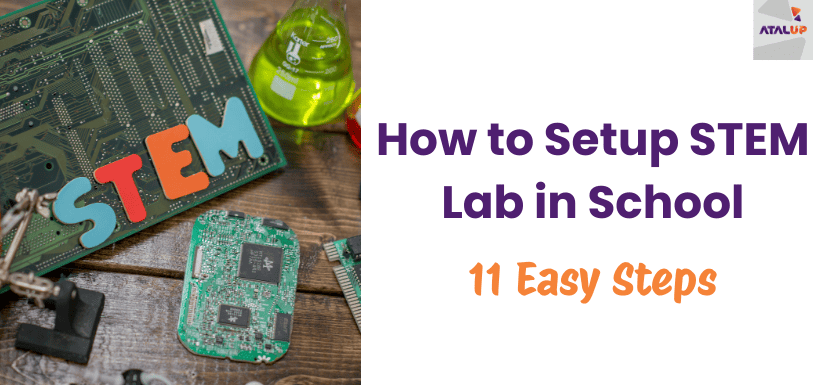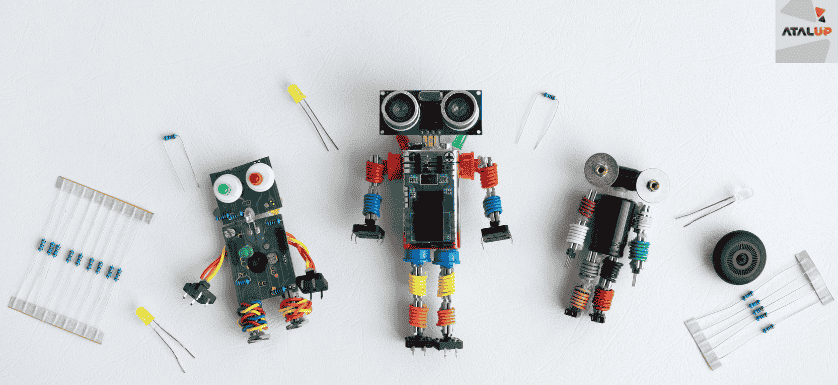
If you’re thinking of building a STEM lab in school, you’re already on the path to transforming your students’ future. But before jumping into budgets or equipment, let’s understand what is STEM lab, why it’s important, and how exactly to set one up step-by-step.
What is STEM Lab?
Let’s begin with the basics. What is STEM lab? A STEM lab is a hands-on learning environment where students explore Science, Technology, Engineering, and Mathematics through experiments, models, and real-world projects. It’s not just a room with fancy gadgets. It’s a space that nurtures curiosity, creative problem-solving, and innovation.
In simple terms, a STEM lab in school acts like a playground for thinkers and tinkerers. Students build machines, code apps, study circuits, and conduct chemistry experiments under one roof. The goal is to make science and math fun, practical, and future-ready.
The experiments are based on real problems like traffic, pollution, security, etc. Students can also build projects that can be converted into excellent business opportunities.
Did you know that the government of India has already established 10,000 Atal Tinkering Labs i.e. STEM labs in different corners of the country? The government is all set to establish next 50,000 Atal Tinkering Labs from 2025. Each school will receive a ₹20 lakh ATL grant to establish and run the lab successfully. Wonder why our government is spending so much on STEM labs? Let’s understand.
Difference Between STEM Lab and Science Lab
Focus Area
- Science Lab: Focuses on biology, physics, and chemistry experiments.
- STEM Lab: Covers science + technology, engineering, and math with integrated problem-solving.
Learning Style
- Science Lab: Mostly follows textbook experiments.
- STEM Lab: Encourages hands-on, project-based, and real-world learning.
Tools & Equipment
- Science Lab: Beakers, microscopes, test tubes, etc.
- STEM Lab: Robotics kits, coding tools, 3D printers, sensors, and electronics.
Skills Developed
- Science Lab: Observation, hypothesis, analysis.
- STEM Lab: Critical thinking, innovation, teamwork, design thinking.
Approach
- Science Lab: Subject-specific and theoretical.
- STEM Lab: Interdisciplinary and application-oriented.
Why Set Up a STEM Lab in School?
You may wonder, why invest in a STEM lab in school? Here’s why:
Bridges the gap between theory and practice
STEM labs in India help students connect textbook knowledge with real-world application. We still wonder where to use Sin Cos in our regular lives. The government wants our students to understand the theory and implement their learnings right away in practical forms. Doing is the best way to learn anything.
Boosts critical and design thinking
Students don’t just memorize, they design, test, fail, and try again. 1+1=2 is not the only way kids can learn. Our older syllabus is all about theory and hence the NEP 2020 has decided to focus on critical and design thinking. Here, students can think and analyze facts with curiosity. This design thinking helps world’s top developers to find answers for complex challenges.
Prepares for 21st-century careers
Most modern jobs demand STEM skills. A STEM lab in school builds that foundation early. India is expected to require over 1 million data science professionals by 2026, as per a report by NASSCOM. Parents who feel that good academic scores are important to secure good jobs must understand the changing trends. STEM learning is the new education style. You can check out these amazing and smartly curated 20 STEM career options.
Fosters teamwork and leadership
Projects in STEM labs require collaboration, just like in the real world. Hence, students learn team work and can learn from each other. While working in teams, students not only learn each other’s ideas but also understand the importance of SWOT analysis.
Now, let’s see how you can setup a STEM lab in school.
How to Setup STEM Lab in School?
Step 1: Identify Your Vision and Objectives
Before buying kits or hiring trainers, decide what you want your STEM lab in school to achieve.
Ask yourself:
- Do you want it integrated into your curriculum?
- Will the lab focus more on robotics, electronics, or science experiments?
- What age group are you targeting?
Your vision will drive all future decisions, from the equipment you choose to the kind of trainers you hire.
Step 2: Get the Basics of ‘What is STEM Lab’ Right
Understanding what is STEM lab helps you make better infrastructure choices. It’s not about expensive devices; it’s about functional, flexible learning. So make sure your lab supports:
- Project-based learning
- Hands-on kits and tools
- Collaborative workstations
- Tech infrastructure like computers and Wi-Fi
The clearer your understanding of what is STEM lab, the better you’ll plan the layout and equipment.
Step 3: Choose the Right Location in Your School
Your STEM lab in school needs an accessible, safe, and distraction-free space. Ideally, go for a room with:
- Adequate ventilation
- Washbasins (for chemical or bio experiments)
- Storage space for tools and raw materials
- Proper lighting
Make sure there’s enough power backup and plug points for computers, 3D printers, or other tools.
Step 4: Budget Planning – What to Include
Setting up a STEM lab in school can be cost-effective if done smartly. Here’s a rough checklist to prepare your budget:
- STEM Kits (electronics, robotics, science experiments)
- Computers or tablets
- Internet and networking equipment
- Safety gear (goggles, gloves)
- Worktables, stools, and whiteboards
- Software licenses (for coding or simulations)
- Teacher training costs
If you know what is STEM lab meant to be, you won’t overspend on fancy but unused gadgets.
Step 5: Pick the Right STEM Kits and Tools
Not all tools work for every school. Choose kits based on:
- Grade levels
- Curriculum compatibility
- Ease of use
- Reusability

For a good STEM lab in school, include kits in:
- Robotics – Like LEGO Mindstorms or Makeblock
- Electronics – Breadboards, sensors, Raspberry Pi
- Science experiments – Chemistry and physics kits
- 3D Printing – Entry-level printers for prototyping
- Coding tools – Arduino, Scratch, Python
Understanding what is STEM lab in practical terms will guide this selection better than blindly copying others.
Step 6: Train the Teachers
You can’t run a STEM lab in school if your teachers don’t know how to use it. Plan professional development workshops where they learn:
- The concept of what is STEM lab
- How to use each tool and kit
- How to conduct inquiry-based learning
- How to integrate lab activities into subjects
This training should be continuous, not a one-time thing. There are some advanced and easy-to-use platforms built exclusively for STEM learning. You can check our Stemious where teachers and students can learn any complex concepts in a simple step-by-step manner.
Step 7: Create a Curriculum Plan
Your STEM lab in school should not be a one-off activity zone. Build a structured curriculum that includes:
- Weekly lab sessions
- Thematic projects (ex: clean energy, smart agriculture)
- Competitions and exhibitions
- Assessment frameworks for student performance
Answering what is STEM lab in your curriculum document also helps align all stakeholders, teachers, students, and parents.
Step 8: Safety Protocols and Lab Rules
A STEM lab in school is fun, but it involves sharp tools, electric components, and chemicals. Draft simple, visual safety instructions for:
- First aid access
- Emergency exits
- Safe handling of tools
- Clean-up and maintenance routines
Understanding what is STEM lab also means knowing how to maintain safety without killing creativity.
Step 9: Encourage Student Ownership
Let students take the lead. Assign roles like:
- Lab Captain
- Tool Manager
- Documentation Incharge
When students feel the STEM lab in school is “their space,” they engage better. Host regular exhibitions where they present their innovations.
This is where the spirit of what is STEM lab truly comes alive, by empowering young minds.
Step 10: Collaborate with Industry or EdTech Partners
Along with government’s Atal Tinkering Lab, you can get support from industry ed-tech leaders. Many startups and CSR initiatives support schools setting up STEM lab in school. Reach out for:
- Sponsorships
- Mentorship programs
- Guest lectures
- Live demos
These partnerships can also help students understand what is STEM lab from an industry lens, bridging the gap between school and real-world careers.
Step 11: Monitor, Review, Improve
Finally, track progress regularly. How many projects are done? What are students learning? Are all kits being used?
Use feedback forms and monthly reviews to keep your STEM lab in school dynamic and outcome-driven. Ask yourself: are we still sticking to the core idea of what is STEM lab?
Final Words
Students’ future lies within the STEM lab in school. Many schools have already established STEM labs and thousands of schools are ready to apply for the next Atal Tinkering Labs. At ATALUP, we help schools get ATL grant and execute activities smoothly. Our team automates the entire process for schools and enables better STEM projects.